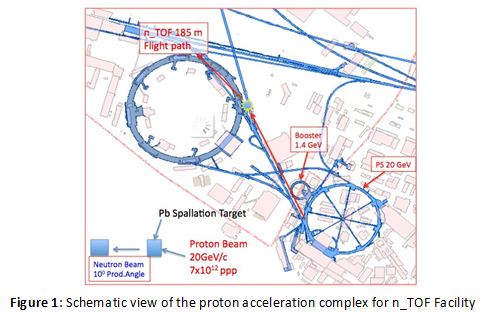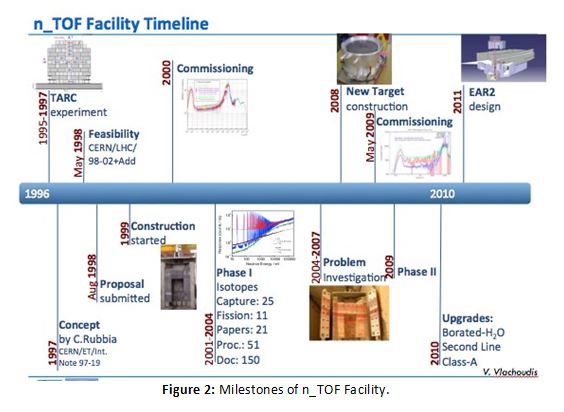PRESENT STATUS AND FUTURE PROGRAMS OF THE n_TOF EXPERIMENT
High precision neutron cross-‐section data are of major importance for a wide variety of research fields in basic and applied nuclear physics [1]. In particular, neutron data on neutron-‐nucleus reactions are essential in Nuclear Astrophysics for understanding the production rate of heavy elements in the Universe, which occurs mainly through slow and rapid neutron capture processes during the various phases of stellar evolution [2,3]. In the field of nuclear technology new studies aimed at developing future generation nuclear system which would address major safety, proliferation and waste concerns are requiring more accurate data in neutron-‐induced fission and capture cross-‐section on radioactive isotopes.
1. n_TOF FACILITY
The idea of a new neutron time-‐of-‐flight facility at CERN was proposed by C. Rubbia in 1998 [4], as a follow up of the TARC experiment, also conducted at CERN.

The concept of the n_TOF neutron beam makes use of both the specifically high flux of neutrons attainable using the spallation process of 20 GeV/c protons on a massive lead target (see Fig.1), able to contain practically the whole spallation shower as well as the remarkable instantaneous beam intensity of the CERN Proton Synchrotron (PS). After the initial proposal in 1998, the facility was then accepted for construction by CERN in 1999. The CERN n_TOF facility has been set in operation and commissioned in 2001 with performances matching the expectations. The PS machine of CERN can generate high intensities up to 8.5×1012 ppp (protons per pulse) -‐ high enough to produce the vast number of 4×101neutrons per pulse -‐ in the form of short (6 ns width) pulses with a repetition time varying from 1.2 s to 16.7 s and a prompt “flash” considerably smaller compared to electron machines. The high neutron flux, the low repetition rates and the excellent energy resolution of 5.5x10-4 (1 keV) have opened new possibilities for high precision cross section measurements in the energy range from thermal to GeV, for stable and, in particular -‐ taking advantage of the high instantaneous neutron flux -‐ for radioactive targets.
After three years long stop due to cooling water activation by spallation products diluted in the water, a new lead target was constructed, and new monitoring systems developed in order to meet safety requirements for the restart of the facility. The new target assembly consists of a separated cooling and moderator circuit, which enables the use of different moderator materials, thus allowing a greater flexibility on the characteristics of the neutron beam.
Another upgrade performed during the 2010 run has been the transformation of the n_TOF experimental area into a Work Sector Type A, which has allowed the possibility to perform measurements of capture and fission cross-‐section of “unsealed” samples of highly radioactive isotopes, such as actinides like 241Am, 243Am and 242Pu, taking full advantage of the facility’s high instantaneous neutron flux. This has required a complete revision of the experimental area and of the related technical services. The milestones of n_TOF facility since its inception is summed-‐up in Fig.2

II. NOTABLE RESULTS ON CAPTURE AND FISSION CROSS SECTION
During the first years of operation 2001-‐2004 the n_TOF collaboration has attained a rich experimental program measuring in total 36 isotopes and producing numerous scientific papers and proceedings.
One example of the n_TOF measurement capabilities and of the vast experimental campaign is given by the measurement of the capture cross-‐section of 186Os and 187Os, which has resulted also in a series of featured articles on Phys. Rev. C [5]. The precise determination of the neutron capture cross sections of these two isotopes is important to define the s-‐process abundance of 187Os at th formation of the solar system. This quantity can be used to evaluate the radiogenic component of the abundance of 187Os due to the decay of the unstable 187Re (t1/2 = 41.2 Gyr) and from this to infer the time duration of the nucleosynthesis in our galaxy (the so-‐called “Re/Os cosmochronometer”). The neutron capture cross sections of 186Os, 187Os, and188Os have been measured at the CERN n TOF facility from 1 eV to 1 MeV, covering the entire energy range of astrophysical interest. The corresponding stellar cross sections have been used to separate the radiogenic part of the 187Os abundance from its s-‐process component and to define the mother/daughter ratio 187Re/187Os.By means of a schematic model which assumes an exponentially decreasing production rate for 187Re, it was shown that the new data limit the nuclear physics uncertainties for the rhenium-‐osmium clock to less than 1 Gyr, allowing a more accurate estimate for the age of our galaxy: the age of the universe by means of the Re/Os clock is claimed to be 15.3±0.8±2 Gyr.
An example of fission cross section measured at n_TOF is the 245Cm(n,f) [6]. Transuranium elements (TRU) such as Np, Pu, Am, and Cm are built up as a result of multiple neutron captures and radioactive decays in all presently operating nuclear reactors based on the U/Pu nuclear fuel cycle. Some highly radioactive isotopes of these elements constitute the most important hazard for nuclear waste management. Several proposals have been made in recent years to reduce the radiotoxicity of nuclear waste containing TRU. Clearly, any kind of system designed to burn nuclear waste, critical or subcritical, thermal or fast, will need to be loaded with fuel containing a large fraction of TRU. The response of these systems (e.g., with respect to criticality) in the presence of TRU is directly linked to the fission cross sections of these isotopes. These fission cross sections are therefore key elements in assessing the strategy to be followed in detailed feasibility studies and in the engineering design of nuclear waste transmutation systems, i.e., Generation IV fast reactors or advanced nuclear waste burners. The 245Cm(n,f) neutron-‐induced fission cross-‐section has been measured at n_TOF – in a single measurement -‐ from 30 meV to 1 MeV neutron energy with an overall systematic uncertainties close to 5%; significant discrepancies with previous measurement and with evaluated databases – in selected energy regions -‐ have been observed and new evaluations will take into account these new data to extract a coherent and up-‐to-‐date cross-‐section description.
III.FEASIBILITY STUDY FOR EXPERIMENTAL AREA 2 (EAR-‐2)
The overall efficiency of the experimental program and the range of possible measurements could be significantly improved with the construction of a 2ndExperimental Area (EAR-‐2), vertically located 20 m on top of the n_TOF spallation target [7].The realization of the 2ndExperimental Area, with its short flight path, will contribute to a substantial improvement in experimental sensitivities and will open a new window to stellar nucleosynthesis, nuclear technology (such as transmutation devices or improvement of safety margins of present and future nuclear energy systems) and basic nuclear physics by allowing to measure neutron-‐induced reactions which are not or difficult to access so far at any other presentlyoperating installation.
The main advantages of the 2nd Experimental Area are the following:
Neutron-‐induced reaction measurements can be performed on very small mass samples. This feature is crucial to reduce the activity of unstable samples and in cases where the available sample material is limited.(ex. 238Pu, 242Pu 243Cm, 244Cm, 245Cm, 242Am,231Pa, 233Pa)
Measurements can be performed on isotopes with very small cross sections for which the optimization of the signal/background ratio is an essential prerequisite (ex. 86Kr, 138Ba, 140Ce, 208Pb )
Measurements can be performed on much shorter time scales; repeated runs with modified conditions are essential to check corrections and to reduce systematic uncertainties.
Measurements of neutron-‐induced cross sections at high energies (En>10-‐100 MeV), which are difficult to perform in the existing EAR-‐1, will benefit. This will be particularly important for measurements of (n, charge particle) reactions at high energies.
IV. CONCLUSION
The CERN n_TOF facility has proven to be a unique facility in the world for its performance. Since 2001, with its rich scientific program, the n_TOF experiment is contributing to the world efforts aimed at collecting high quality data, mostly on capture and fission neutron-‐induced reactions. The realization of the Experimental Area 2 (EAR-‐2) with its enhanced capabilities will be of utmost importance for the neutron physics community and will also be complementary to other future installations; due to the unique neutron beam characteristics the installation will open new opportunities for measurements of neutron-‐induced reactions with unprecedented accuracy for various important fields of physics, among which nuclear technology, nuclear astrophysics and stellar evolution, basic research, medical applications, dosimetry and radiation damage studies.
REFERENCES
[1] E. Chiaveri et al. “Past, Present and future of the n_TOF facility”, Journal of the Korean Physical
Society, Vol. 59, No. 2, August 2011, pp. 1620_1623
[2] F. Kaeppeler, Progr. Particles Nucl. Phys. 43 (1999) 439
[3] G. Wallestein et al. Rev. Mod. Phys. 69 (1997) 995
[4] C. Rubbia et al., “A high Resolution Spallation Driven Facility at the CERN-‐PS to measure Neutron
Cross Sections in the Interval from 1 eV to 250 MeV”, CERN/LHC/98-‐02(EET)+Add1
[5] n_TOF Collaboration, http://physics.aps.org/synopsis-‐for/10.1103/PhysRevC.82.015802
[6] M. Calviani et al. (n_TOF Collaboration), Phys. ReV. C 85, 034616 (2012)
http://link.aps.org/doi/10.1103/PhysRevC.85.034616
[7] E. Chiaveri et al. “Proposal for n_TOF Experimental Area 2 (EAR-‐2)”,
(https://cdsweb.cern.ch/record/1411635?ln=en )
